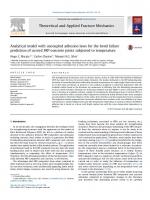Analytical model with uncoupled adhesion laws for the bond failure prediction of curved FRP-concrete joints subjected to temperature
- Citation:
- Analytical model with uncoupled adhesion laws for the bond failure prediction of curved FRP-concrete joints subjected to temperature, Biscaia, Hugo C., Chastre Carlos, and Silva Manuel A. G. , Theoretical and Applied Fracture Mechanics, Volume 89, p.63-78, (2017) copy at https://docentes.fct.unl.pt/cmcr/publications/analytical-model-uncoupled-adhesion-laws-bond-failure-prediction-curved-frp-concre

Abstract:
The strengthening of structures such as columns, beams, arches or slabs with Fibre Reinforced Polymers (FRP) has been the focus of several studies. However, the studies dedicated to the FRP debonding phenomenon of curved bonded joints affected by elevated temperatures are surprisingly limited and no studies on this topic are known, at present, to use nonlinear analytical or numerical approaches. Still, the available studies found in the literature are unanimous in affirming that the debonding phenomenon on such curved interfaces demands the interaction between Fracture Modes I and II. The present work aims to develop an analytical solution capable of simulating the debonding process of curved CFRP-toconcrete interfaces with a constant radius subjected to mechanical and/or thermal loads. Some examples are presented in which the influence of the radius of the interface and the temperature level is analysed. The analytical solution proposed here is based on adhesion laws in which, in the case ofMode II, an exponential bond vs. relative displacement law with temperature dependency is assumed, whereas the Mode I adhesive law is based on a linear with fragile rupture law with the same temperature dependency as Mode II.
Notes:
n/a
